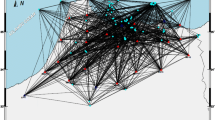Abstract
Numerical modelling ofSH wave seismograms in media whose material properties are prescribed by a random distribution of many perfectly elastic cavities and by intrinsic absorption of seismic energy (anelasticity) demonstrates that the main characteristics of the coda waves, namely amplitude decay and duration, are well described by singly scattered waves in anelastic media rather than by multiply scattered waves in either elastic or anelastic media. We use the Boundary Integral scheme developed byBenites et al. (1992) to compute the complete wave field and measure the values of the direct waveQ and coda wavesQ in a wide range of frequencies, determining the spatial decay of the direct wave log-amplitude relation and the temporal decay of the coda envelope, respectively. The effects of both intrinsic absorption and pure scattering on the overall attenuation can be quantified separately by computing theQ values for corresponding models with (anelastic) and without (elastic) absorption. For the models considered in this study, the values of codaQ −1 in anelastic media are in good agreement with the sum of the corresponding scatteringQ −1 and intrinsicQ −1 values, as established by the single-scattering model ofAki andChouet (1975). Also, for the same random model with intrinsic absorption it appears that the singly scattered waves propagate without significant loss of energy as compared with the multiply scattered waves, which are strongly affected by absorption, suggesting its dominant role in the attenuation of coda waves.
Similar content being viewed by others
References
Aki, K. (1969),Analysis of Seismic Coda of Local Earthquakes as Scattered Wave, J. Geophys. Res.74, 615–631.
Aki, K. (1995),Interrelation between Fault Zone Structures and Earthquake Processes, Pure and Appl. Geophys.145, 1134–1164.
Aki, K., andChouet, B. (1975),Origin of Coda Waves: Source, Attenuation, and Scattering Effects, J. Geophys. Res.80, 3322–3342.
Aki, K., andRichards, P. G.,Quantitative Seismology: Theory and Methods (W. H. Freeman, San Francisco 1980).
Benites, R., Aki, K., andYomogida, K. (1992),Multiple Scattering of SH Waves in 2-D Media with Many Cavities, Pure and Appl. Geophys.138, 353–390.
Frankel, A., andClayton, R. (1986),Finite-difference Simulations of Seismic Scattering: Implications for the Propagation of Short-period Seismic Waves in the Crust and Models of Crustal Heterogeneities, J. Geophys. Res.74 2167–2186.
Frankel, A., andWennerberg, L. (1987),Energy-flux Model of Seismic Coda: Separation of Scattering and Intrinsic Attenuation, Bull. Seismol. Soc. Am.77, 1223–1251.
Haar, R. N. (1989),Spectra and Time Decay of Coda, Ph.D. Thesis, Stanford University.
Hoshiba, M. (1991),Simulation of Multiple-scattered Coda Wave Excitation Based on the Energy Conservation Law, Phys. Earth Planet. Inter.67, 123–136.
Rautian, T. G., andKhalturin, V. I. (1978),The Use of the Coda for Determination of the Earthquake Source Spectrum, Bull. Seismol. Soc. Am.68, 923–948.
Roth, M., andKorn, M. (1993),Single Scattering Theory versus Numerical Modelling in 2-D Random Media, Geophys. J. Int.112, 124–140.
Sato, H. (1977),Energy Propagation Including Scattering Effect, Single Isotropic Scattering Approximation, J. Phys. Earth25, 27–41.
Takahara, M., andYomogida, K. (1992),Estimation of Coda Q Using the Maximum Likelihood Method, Pure and Appl. Geophys.139, 255–268.
Wennerberg, L. (1993),Multiple-scattering Interpretations of Coda-Q Measurements, Bull. Seismol. Soc. Am.83, 279–290.
Wu, R. S. (1982),Attenuation of Short-period Seismic Waves due to Scattering, Geophys. Res. Lett.9, 9–12.
Wu, R. S. (1985),Multiple Scattering and Energy Transfer of Seismic Wave: Separation of Scattering Effect from Intrinsic Attenuation, I. Theoretical Modeling, Geophys. J. Roy. Astr. Soc.82, 57–80.
Xu, T., andMcMechan, G. A. (1995),Composite Memory Variables for Viscoelastic Synthetic Seismograms, Geophys. J. Int.121, 634–639.
Yomogida, K., andBenites, R. (1995),Relation between Direct Wave Q and Coda Q: A Numerical Approach, Geophys. J. Int.123, 471–483.
Zeng, Y. H., Su, F., andAki, K. (1991),Scattering Wave Energy Propagation in a Random Isotropic Scattering Medium, 1. Theory, J. Geophys. Res.96, 607–620.
Author information
Authors and Affiliations
Rights and permissions
About this article
Cite this article
Yomogida, K., Benites, R. CodaQ as a combination of scattering and intrinsic attenuation: Numerical simulations with the boundary integral method. PAGEOPH 148, 255–268 (1996). https://doi.org/10.1007/BF00882062
Received:
Revised:
Accepted:
Issue Date:
DOI: https://doi.org/10.1007/BF00882062




